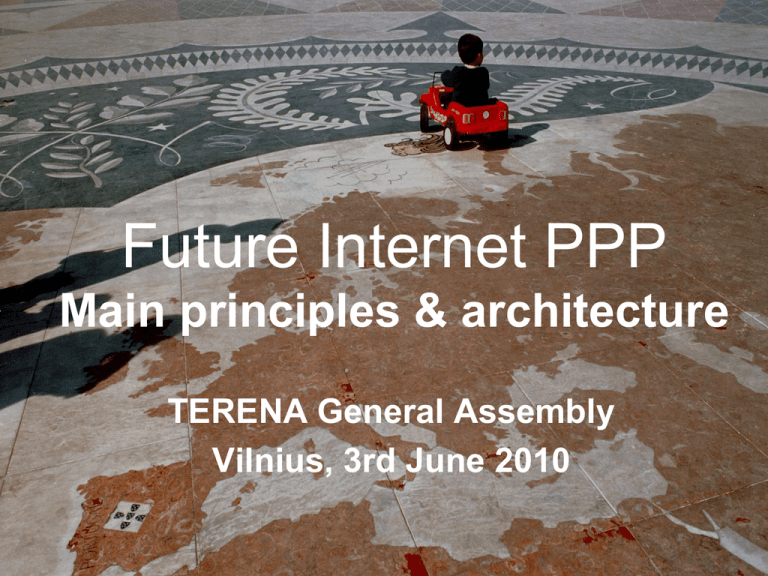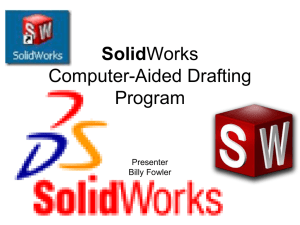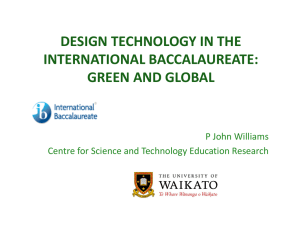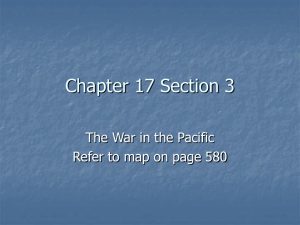Presentation by Jean-Luc Dorel, European Commission
advertisement

Future Internet PPP Main principles & architecture TERENA General Assembly Vilnius, 3rd June 2010 The FI PPP: “smarter” infrastructures & business processes through tighter integration with the Internet More INTELLIGENCE Turning data into value More FLEXIBILITY Leveraging the value of “networked” More EFFICIENCY Getting green and sustainable Leverage two trends: 1. Move towards an enhanced Internet 2. Move towards “smarter” business processes Application domains in health, transport, environment, energy, logistics, … Holistic technology + Application approach Foster cross-sector industrial partnerships and “user” driven innovation European Digital Agenda Aspects: Openness and Interoperability Standards Fostering public demand side Further incentives towards very high rate networks Outcome of the FI-PPP 1. The result should be a generic, open and secure communication and service platform… standardised and providing cross sector services through common enablers… 2. Multiple use case scenarios shall be considered. It is anticipated that innovative Internet-enabled smart infrastructures and processes require at least to capitalise on: Sensor Networks, Cloud like service infrastructures, Wireless capabilities 3. Open to “user” driven innovation through multiplicity of Use Cases – Innovation platform for SMEs. Objectives • Increase effectiveness of business processes and the operation of infrastructure supporting applications (transport, health, or energy) • Identify, define and update Internet related requirements from the different use case scenarios, i.e. specs based on user industry requirements • Derive possible new innovative business models to strengthen the competitive position of European industry in domains like telecom, mobile devices, SW & services, content providers & media. • Specify an open standardised generic framework (specs, standards, implementation and research/usage validation trials). • Adapt and complement to the specific needs of the use case scenario, i.e. fostering user innovation based on standards Conceptual Programme Characteristics 1. 2. 3. 4. 5. 6. 7. Large scale projects Integration will not happen in many small projects Flexibility The future Internet is a hard target to follow Create a phased approach Systematic approach to project selection Projects must contribute to the programme and uniquely address aspects of the programme Facilitate open sharing of project foreground IPR issues must not hinder collaboration Integrate sector competence with the ICT competence The PPP target is to enhance all sectors with the Future Internet Lead by example: large scale trials Proving the scalability and viability of the concepts developed Synergy: build on existing results and resources Time & scale dictate using what is already achieved in Europe. Courtesy of the G16/Eurescom Building a Partnership that maximises the outcome The partnerships must bring together various expertise into efficient, small and pro-active innovation teams: Operators, service developers and equipment manufacturers (… ICT industry) Research & innovation stakeholders User industries & user communities (e.g. utilities) Public sector stakeholders (… when it comes pilots) End-user validation (… in particular in the platform expansion phase) The partnerships will evolve over time, in particular: Technology foundation for the Core Platform Use Case scenarios and pilots Programme Architecture Call 2 Call 1 Call 3 Obj 1.10 Programme Facilitation & Support (CSA) Obj 1.9 Capacity Building & Infrastructure (CSA) SME Innovation Obj 1.9 Capacity Building (IP) Obj 1.8 Use Case Scenarios (IP) Obj 1.8 Use Case Trials (IP) Up to 8 Use Case Scenarios Up to 5 Trials Obj 1.8 Use Case Scenarios (IP) Obj 1.8 Use Case Trials (IP) 3rd Call Use Case Expansion Phase Obj 1.8 Use Case Scenarios (IP) Obj 1.7 Technology Foundation (IP) 2010 2011 2012 Phase 1 2013 Phase 2 TF Continuation (IP) 2014 2015 Phase 3 Technology Foundation: FI Core Platform • Generic, trusted, open platform: Call 3 Obj 1.10 Programme Facilitation & Support (CSA) – Typical generic enablers with functionalities for • • • • • • • Call 2 Call 1 upgraded network information processing sensor networks coupled to the Internet versatile service infrastructure real-time application trust and identity ad-hoc aggregation of resources Obj 1.9 Capacity Building & Infrastructure (CSA) SME Innovation Obj 1.9 Capacity Building (IP) Obj 1.8 Use Case Scenarios (IP) Obj 1.8 Use Case Trials (IP) Up to 8 Use Case Scenarios Up to 5 Trials Obj 1.8 Use Case Scenarios (IP) Obj 1.8 Use Case Trials (IP) 3rd Call Use Case Expansion Phase Obj 1.8 Use Case Scenarios (IP) Obj 1.7 Technology Foundation (IP) 2010 2011 2012 Phase 1 TF Continuation (IP) 2013 2014 2015 Phase 3 Phase 2 (part of the ICT work programme 2013) – open interfaces, API, SDK • • Functionalities depend on the requirements of the use case scenarios Build on existing research results: – system view – integration – adding missing components • • Re-usable/composable in multiple usage contexts 3rd party access under FRAND One IP (41 MEuro, 3 years) covering Phases 1 and 2: • • • • 30% flexible budget for meeting use case needs system design early prototyping early implementation and validation Use Case Scenarios and Early Trials • • Use cases with high social and economic impact Vertical application scenarios: Call 2 Call 1 Call 3 Obj 1.10 Programme Facilitation & Support (CSA) Obj 1.9 Capacity Building & Infrastructure (CSA) – with enhanced efficiency, sustainability, performance by tighter integration with advanced Internet capabilities SME Innovation Obj 1.9 Capacity Building (IP) Obj 1.8 Use Case Scenarios (IP) Obj 1.8 Use Case Trials (IP) Up to 8 Use Case Scenarios – leapfrogging advanced internet technologies, such as • • • • • • • context awareness and sensor networks advanced real time information processing handling huge volume of data ad-hoc service composition and mash ups managed broadband connectivity and services embedded media support Up to 5 Trials Obj 1.8 Use Case Scenarios (IP) Obj 1.8 Use Case Trials (IP) 3rd Call Use Case Expansion Phase Obj 1.8 Use Case Scenarios (IP) Obj 1.7 Technology Foundation (IP) 2010 2011 2012 Phase 1 2013 TF Continuation (IP) 2014 2015 Phase 3 Phase 2 (part of the ICT work programme 2013) Identification of generic versus specific enablers (collaboration with TF) Phase 1 (competitive) • Up to 8 IPs (5 MEuro, 2 years) with broad coverage • specification of use cases & scenarios • identification of generic and specific enablers • conceptual prototypes • Phase 2 implementation plan Phase 2 (competitive) • Up to 5 IPs (13.5 MEuro, 2 years) with 10% flexible budget (local business ecosystems) • working experimentation sites with generic and specific enablers available • selected test applications implemented • validation of openness and versatility of the core platform • planning phase 3 Programme Dependencies 4 Develop domain specific platform instantiation – based on 1 Up to 8 Use Case Scenarios Obj 1.8 Use Case Scenarios (IP) Obj 1.8 Use Case Scenarios (IP) Generic platform functionalities Use case specifications Obj 1.8 Use Case Scenarios (IP) 3 Obj 1.7 Technology Foundation (IP) 2 Define generic enabler and develop generic functionalities FI-PPP: Pilot Architecture Pilot B.3 Use Case A Use Case B Use Case C Pilot B.2 Use Case D Pilot B.1 Pilot B.4 Pilot A.3 & Pilot C.2 • Geographically dispersed but some co-locations considered useful • No pilot is an island • Existing local ecosystem nucleus from which to grow Capacity Building & Infrastructure Support • Leverage existing public investments in advanced infrastructures Examples for infrastructures Obj 1.9 Capacity Building & Infrastructure (CSA) SME Innovation Obj 1.9 Capacity Building (IP) Obj 1.8 Use Case Scenarios (IP) Obj 1.8 Use Case Trials (IP) Up to 8 Use Case Scenarios Up to 5 Trials Obj 1.8 Use Case Scenarios (IP) Obj 1.8 Use Case Trials (IP) 2010 2011 2012 Phase 1 2013 TF Continuation (IP) 2014 2015 Phase 3 Phase 2 (part of the ICT work programme 2013) Establish partnership agreements Complementary to Use Case infrastructures Phase 1 • one CSA (3 MEuro, 3 years) overlapping with phase 2 • identify candidates for experimental infrastructures for large scale experimentation • repository of infrastructures • identify operational constraints and draft partnership agreement across the programme 3rd Call Use Case Expansion Phase Obj 1.8 Use Case Scenarios (IP) Obj 1.7 Technology Foundation (IP) – GEANT and National Research and Education Networks – FIRE - Future Internet Research & Experimentation – Advanced city and regional infrastructures • • Call 3 Obj 1.10 Programme Facilitation & Support (CSA) – to support large scale and diverse experiments – to demonstrate versatility of the core platform – to support testing across a multiplicity of heterogeneous trials and use cases • Call 2 Call 1 Phase 2 • one IP (12.5 MEuro, 2 years) • integration of infrastructures for cross-cutting phase 2 and 3 trials as needed • adaptation, upgrade, validation of infrastructures for phase 3 • assembly of a pan-European federation to support application mash-up Programme Facilitation and Support • Establish the adequate mechanisms for collaborations between projects – – – – – • boards and advisory structure day-to-day management support synchronisation & management of dependencies mechanisms for conflict resolution progress monitoring • Obj 1.9 Capacity Building & Infrastructure (CSA) Obj 1.8 Use Case Scenarios (IP) Obj 1.8 Use Case Trials (IP) Up to 8 Use Case Scenarios Up to 5 Trials Obj 1.8 Use Case Scenarios (IP) Obj 1.8 Use Case Trials (IP) 3rd Call Use Case Expansion Phase Obj 1.8 Use Case Scenarios (IP) Obj 1.7 Technology Foundation (IP) 2010 2011 2012 Phase 1 2013 Phase 2 TF Continuation (IP) 2014 2015 Phase 3 (part of the ICT work programme 2013) SME-oriented measures One Support Action covering Phases 1 to 3 (6 MEuro, 3 years) Contribution to policy and regulatory discussion – operation of the FI framework to be developed – towards an internal market for e-services • SME Innovation Obj 1.9 Capacity Building (IP) – towards ecosystems for trials in Phases 2 and 3 – awareness, training and incentive schemes • Call 3 Obj 1.10 Programme Facilitation & Support (CSA) Co-ordination of standardisation and assurance of openness – certification programmes – strategic contribution to international standardisation – programme-level IPR regime Call 2 Call 1 Public Relations – programme-wide PR strategy – individually address all relevant target audiences – coordinate common dissemination actions • • • facilitator for collaboration in support of and complementary to the EC management, monitoring and review processes ensuring coherent and nondisruptive management support The process • The work programme is specific in calling for the different elements making up the programme (WP2011/12 calls for Phase 1 and 2, WP2013 will call for Phase 3). • Reflecting the programme notion is an absolute requirement for all proposals – observe the system context! • Phased projects, limited number, critical mass = many specific programme characteristics • An evaluation process catering for the specificities of the PPP. • Leverage user driven innovation and public sector strengths through openness and existing infrastructures. • Manage dependencies – in particular between Technology Foundation and Use Cases. • Significant programme coordination and support measures expended by each project and the Programme Facilitation action. Draft Implementation Roadmap* Call 1 (30 July – 26 October 2010) – budget 90 MEuro Technology Foundation (one IP, 41 MEuro, 3 years, 30% flexible) Use Case Scenarios – Phase 1 (7-8 areas, IP, 5 MEuro, 2 years) Capacity Building (one CSA, 3 MEuro, 3 years) Programme support (one CSA, 6 MEuro, 5 years) Call 2 (15 May – 18 September 2012) – budget 80 MEuro Use Case Scenarios Pilots – Phase 2 (5 areas, 13.5 MEuro, 2 years) Capacity Building (one IP, 12.5 MEuro, 2 years) Call 3 (mid 2013) – budget 130 MEuro Devoted to the expansion and enlargement of many testbeds and pilots (several areas, ~100 MEuro, 2 years) *Subject to Member states approval in June ‘10 Further Information Next Key Events 2010/11: Sites to drill further: • 27-29 September – Brussels, • ec.europa.eu/foi – read about the many activities ICT Event 2010 the EC undertakes on • 29 Nov – 1 Dec – Tokyo, Future Internet IoT2010 • www.future-internet.eu – • 16-17 December – Ghent, 6th The European Future FIA Conference Internet Portal – the community site th • 17-19 May – Budapest, 7 • cordis.europa.eu/ict/ch1 – FIA Conference Ongoing European FI research & development activities A Creative Union of 497 Million people A Creative Union of 497 Million people Back-up ICT Work Programme 2011-12 Total available budget: Euro 2.4 billion Proposal includes 8 Challenges + FET Challenge 1 represents a major share (≈ 25%) Future Internet - 2 strands under CH1: Mainstream research on: networks,networked media, sensor platform, services & cloud, trust & security, FIRE approach based on continuity. + A number of new issues under CH1 core objectives FI-PPP Closing the gap between research and innovation Landscape of Future Internet Activities in Europe FP7 Challenge 1 100 projects covering research in communications, networks, media technologies, software and services, trust and security and the Internet of things. Started: 2006 European European Institutions FI-PPP FIA - Constituency building - Future research trends - FIA constituency impact - FIA conference & workshops - FIA scientific book Started 2008 - European Council - European Parliament - Committee of Regions - Economic & Social Committee Innovation oriented FI research partnership Started: 2011 FP8 and post PPP - Japan - United States - Canada - China Representatives of EU Member states and FP7 associated countries. Started 2009 FI Forum Representatives of EU Member states and FP7 associated countries. Started 2009 National FI Initiatives EUREKA National - CELTIC (communications) - CATRENE (nano-electronics) - EURIPIDES (microsystems) - ITEA2 (software) More than 15 European countries have national FI focussed RTD & Innov. actions ongoing. Research FI in international context Pilots Innovation Policy






